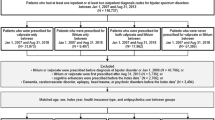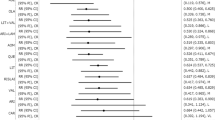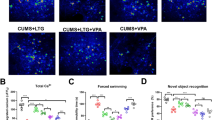Abstract
Both lithium and valproate are well-established treatments for bipolar disorder. Studies have also found that lithium is effective at reducing suicidal behaviors in patients with mood disorders. Impulsivity is a validated endophenotype of both bipolar disorder and suicidal behavior. We assessed effects of treatment with lithium or valproate on cognitive impulsivity in selectively bred mice previously shown to manifest relatively high levels of cognitive impulsivity. Mice were trained in the delay-discounting paradigm, a measure of cognitive impulsivity reflecting a behavioral bias towards immediacy, and then treated with lithium, valproate, or control chow. After 3 weeks of drug treatment, mice were tested at various delays to a large, delayed reward. Drug treatment continued during this time. Lithium reduced impulsivity, whereas valproate had no effect on choice behavior. Both drugs increased the number of choice trials and reinforcer intake, but effects on choice behavior did not depend on these motivational changes. To our knowledge, this is the first study demonstrating lithium’s effects to reduce cognitive impulsivity. Future studies may focus on the ability of putative pharmacotherapies for patients at risk for bipolar disorder or suicide to modify the impulsive choice dimension of this diseases.
Similar content being viewed by others
Log in or create a free account to read this content
Gain free access to this article, as well as selected content from this journal and more on nature.com
or
References
Baldessarini RJ, Tondo L, Davis P, Pompili M, Goodwin FK, Hennen J (2006). Decreased risk of suicides and attempts during long-term lithium treatment: a meta-analytic review. Bipolar Disord 8 (Pt 2): 625–639.
Beaulieu J-M, Sotnikova TD, Yao W-D, Kockeritz L, Woodgett JR, Gainetdinov RR et al (2004). Lithium antagonizes dopamine-dependent behaviors mediated by an AKT/glycogen synthase kinase 3 signaling cascade. Proc Natl Acad Sci USA 101: 5099–5104.
Beaulieu JM, Zhang X, Rodriguiz RM, Sotnikova TD, Cools MJ, Wetsel WC et al (2008). Role of GSK3 beta in behavioral abnormalities induced by serotonin deficiency. Proc Natl Acad Sci USA 105: 1333–1338.
Can A, Blackwell RA, Piantadosi SC, Dao DT, O’Donnell KC, Gould TD (2011). Antidepressant-like responses to lithium in genetically diverse mouse strains. Genes Brain Behav 10: 434–443.
Can A, Grahame NJ, Gould TD (2012). Affect-related behaviors in mice selectively bred for high and low voluntary alcohol consumption. Behav Genet 42: 313–322.
Cipriani A, Pretty H, Hawton K, Geddes JR (2005). Lithium in the prevention of suicidal behavior and all-cause mortality in patients with mood disorders: a systematic review of randomized trials. Am J Psychiatry 162: 1805–1819.
Collins JC, McFarland BH (2008). Divalproex, lithium and suicide among Medicaid patients with bipolar disorder. J Affect Dis 107: 23–28.
Courtet P, Gottesman II, Jollant F, Gould TD (2011). The neuroscience of suicidal behaviors: what can we expect from endophenotype strategies? Transl Psychiatry 1: 1–7.
Dorrego MF, Canevaro L, Kuzis G, Sabe L, Starkstein SE (2002). A randomized, double-blind, crossover study of methylphenidate and lithium in adults with attention-deficit/hyperactivity disorder: preliminary findings. J Neuropsychiatry Clin Neurosci 14: 289–295.
Etain B, Mathieu F, Liquet S, Raust A, Cochet B, Richard JR et al (2012). Clinical features associated with trait-impulsiveness in euthymic bipolar disorder patients. J Affect Dis 144: 240–247.
Evenden J (1999). Impulsivity: a discussion of clinical and experimental findings. J Psychopharmacol 13: 180–192.
Geddes JR, Burgess S, Hawton K, Jamison K, Goodwin GM (2004). Long-term lithium therapy for bipolar disorder: systematic review and meta-analysis of randomized controlled trials. Am J Psychiatry 161: 217–222.
Ghoshdastidar D, Dutta RN, Poddar MK (1989). In vivo distribution of lithium in plasma and brain. Indian J Exp Biol 27: 950–954.
Goodwin FK, Fireman B, Simon GE, Hunkeler EM, Lee J, Revicki D (2003). Suicide risk in bipolar disorder during treatment with lithium and divalproex. JAMA 290: 1467–1473.
Gould TD, Chen G, Manji HK (2002). Mood stabilizer psychopharmacology. Clin Neurosci Res 2: 193–212.
Gould TD, Chen G, Manji HK (2004a). In vivo evidence in the brain for lithium inhibition of glycogen synthase kinase-3. Neuropsychopharmacology 29: 32–38.
Gould TD, Einat H, Bhat R, Manji HK (2004b). AR-A014418, a selective GSK-3 inhibitor, produces antidepressant-like effects in the forced swim test. Int J Neuropsychopharmacol 7: 387–390.
Gould TD (2006). Targeting glycogen synthase kinase-3 as an approach to develop novel mood-stabilising medications. Expert Opin Ther Targets 10: 377–392.
Gould TD, Gottesman II (2006). Psychiatric endophenotypes and the development of valid animal models. Genes Brain Behav 5: 113–119.
Gould TD, Einat H, O'Donnell KC, Picchini AM, Schloesser RJ, Manji HK (2007). Beta-catenin overexpression in the mouse brain phenocopies lithium-sensitive behaviors. Neuropsychopharmacology 32: 2173–2183.
Gould TD, O'Donnell KC, Dow ER, Du J, Chen G, Manji HK (2008). Involvement of AMPA receptors in the antidepressant-like effects of lithium in the mouse tail suspension test and forced swim test. Neuropharmacology 54: 577–587.
Green L, Snyderman M (1980). Choice between rewards differing in amount and delay: toward a choice model of self control. J Exp Anal Behav 34: 135–147.
Grunebaum MF, Ramsay SR, Galfalvy HC, Ellis SP, Burke AK, Sher L et al (2006). Correlates of suicide attempt history in bipolar disorder: a stress-diathesis perspective. Bipolar Disord 8 (Pt 2): 551–557.
Guzzetta F, Tondo L, Centorrino F, Baldessarini RJ (2007). Lithium treatment reduces suicide risk in recurrent major depressive disorder. J Clin Psychiatry 68: 380–383.
Hamburger-Bar R, Robert M, Newman M, Belmaker RH (1986). Interstrain correlation between behavioural effects of lithium and effects on cortical cyclic AMP. Pharmacol Biochem and Behav 24: 9–13.
Hao Y, Creson T, Zhang L, Li P, Du F, Yuan P et al (2004). Mood stabilizer valproate promotes ERK pathway-dependent cortical neuronal growth and neurogenesis. J Neurosci 24: 6590–6599.
Hollander E, Pallanti S, Allen A, Sood E, Baldini Rossi N (2005). Does sustained-release lithium reduce impulsive gambling and affective instability versus placebo in pathological gamblers with bipolar spectrum disorders? Am J Psychiatry 162: 137–145.
Jope RS (2003). Lithium and GSK-3: one inhibitor, two inhibitory actions, multiple outcomes. Trends Pharmacol Sci 24: 441–443.
Klein PS, Melton DA (1996). A molecular mechanism for the effect of lithium on development. Proc Natl Acad Sci USA 93: 8455–8459.
Kovacsics CE, Goyal HK, Thomas KJ, Gould TD (2008). The antisuicidal efficacy of lithium: a review of the clinical literature and underlying pharmacology. Int J Child Health Hum Dev 1: 225–244.
Kovacsics CE, Gottesman II, Gould TD (2009). Lithium's antisuicidal efficacy: elucidation of neurobiological targets using endophenotype strategies. Annu Rev Pharmacol Toxicol 49: 175–198.
Kovacsics CE, Gottesman II, Gould TD (2010). Shock-induced aggression in mice is modified by lithium. Pharmacol Biochem Behav 94: 380–386.
Li X, Zhu W, Roh MS, Friedman AB, Rosborough K, Jope RS (2004). In vivo regulation of glycogen synthase kinase-3beta (GSK3beta) by serotonergic activity in mouse brain. Neuropsychopharmacology 29: 1426–1431.
Lombardo LE, Bearden CE, Barrett J, Brumbaugh MS, Pittman B, Frangou S et al (2012). Trait impulsivity as an endophenotype for bipolar I disorder. Bipolar Disord 14: 565–570.
Mann JJ, Arango VA, Avenevoli S, Brent DA, Champagne FA, Clayton P et al (2009). Candidate endophenotypes for genetic studies of suicidal behavior. Biol Psychiatry 65: 556–563.
Matson LM, Grahame NJ (2011). Pharmacologically relevant intake during chronic, free-choice drinking rhythms in selectively bred high alcohol-preferring mice. Addict Biology.
McElroy SL, Altshuler LL, Suppes T, Keck Jr PE, Frye MA, Denicoff KD et al (2001). Axis I psychiatric comorbidity and its relationship to historical illness variables in 288 patients with bipolar disorder. Am J Psychiatry 158: 420–426.
Melhem NM, Brent DA, Ziegler M, Iyengar S, Kolko D, Oquendo M et al (2007). Familial pathways to early-onset suicidal behavior: familial and individual antecedents of suicidal behavior. Am J Psychiatry 164: 1364–1370.
Mobini S, Chiang TJ, Ho MY, Bradshaw CM, Szabadi E (2000). Effects of central 5-hydroxytryptamine depletion on sensitivity to delayed and probabilistic reinforcement. Psychopharmacology 152: 390–397.
Najt P, Perez J, Sanches M, Peluso MA, Glahn D, Soares JC (2007). Impulsivity and bipolar disorder. Eur Neuropsychopharmacol 17: 313–320.
O’Brien WT, Harper AD, Jove F, Woodgett JR, Maretto S, Piccolo S et al (2004). Glycogen synthase kinase-3beta haploinsufficiency mimics the behavioral and molecular effects of lithium. J Neurosci 24: 6791–6798.
Oberlin BG, Grahame NJ (2009). High-alcohol preferring mice are more impulsive than low-alcohol preferring mice as measured in the delay discounting task. Alcohol Clin Exp Res 33: 1294–1303.
Oberlin BG, Bristow RE, Heighton ME, Grahame NJ (2010). Pharmacological dissociation between impulsivity and alcohol drinking in high alcohol preferring mice. Alcohol Clin Exp Res 34: 1363–1375.
Ohmura Y, Tsutsui-Kimura I, Kumamoto H, Minami M, Izumi T, Yamaguchi T et al (2012). Lithium, but not valproic acid or carbamazepine, suppresses impulsive-like action in rats. Psychopharmacology 219: 421–432.
Oquendo MA, Galfalvy H, Russo S, Ellis SP, Grunebaum MF, Burke A et al (2004). Prospective study of clinical predictors of suicidal acts after a major depressive episode in patients with major depressive disorder or bipolar disorder. Am J Psychiatry 161: 1433–1441.
Oquendo MA, Galfalvy HC, Currier D, Grunebaum MF, Sher L, Sullivan GM et al (2011). Treatment of suicide attempters with bipolar disorder: a randomized clinical trial comparing lithium and valproate in the prevention of suicidal behavior. Am J Psychiatry 168: 1050–1056.
Peluso MA, Hatch JP, Glahn DC, Monkul ES, Sanches M, Najt P et al (2007). Trait impulsivity in patients with mood disorders. J Affect Disord 100: 227–231.
Rachlin H, Green L (1972). Commitment, choice and self-control. J Exp Anal Behav 17: 15–22.
Richards JB, Mitchell SH, de Wit H, Seiden LS (1997). Determination of discount functions in rats with an adjusting-amount procedure. J Exp Anal Behav 67: 353–366.
Shaw JP, Ratcliffe F (1976). Effect of lithium on brain 5-hydroxytryptamine metabolism in mice. Arch Int Pharmacodyn Ther 222: 116–124.
Swann AC, Anderson JC, Dougherty DM, Moeller FG (2001). Measurement of inter-episode impulsivity in bipolar disorder. Psychiatry Res 01: 195–197.
Swann AC, Bowden CL, Calabrese JR, Dilsaver SC, Morris DD (2002). Pattern of response to divalproex, lithium, or placebo in four naturalistic subtypes of mania. Neuropsychopharmacology 26: 530–536.
Swann AC, Pazzaglia P, Nicholls A, Dougherty DM, Moeller FG (2003). Impulsivity and phase of illness in bipolar disorder. J Affect Disord 73: 105–111.
Terao T (2008). Aggression, suicide, and lithium treatment. Am J Psychiatry 165: 1356–1357, author reply 1357.
Tondo L, Jamison KR, Baldessarini RJ (1997). Effect of lithium maintenance on suicidal behavior in major mood disorders. Ann NY Acad Sci 836: 339–351.
Treiser SL, Cascio CS, O’Donohue TL, Thoa NB, Jacobowitz DM, Kellar KJ (1981). Lithium increases serotonin release and decreases serotonin receptors in the hippocampus. Science 213: 1529–1531.
Turecki G (2005). Dissecting the suicide phenotype: the role of impulsive-aggressive behaviours. J Psychiatry Neurosci 30: 398–408.
Weisler RH, Nolen WA, Neijber A, Hellqvist A, Paulsson B (2011). Continuation of quetiapine versus switching to placebo or lithium for maintenance treatment of bipolar I disorder (Trial 144: a randomized controlled study). J Clin Psychiatry 72: 1452–1464.
Winstanley CA, Dalley JW, Theobald DE, Robbins TW (2004). Fractionating impulsivity: contrasting effects of central 5-HT depletion on different measures of impulsive behavior. Neuropsychopharmacology 29: 1331–1343.
Winstanley CA, Eagle DM, Robbins TW (2006). Behavioral models of impulsivity in relation to ADHD: translation between clinical and preclinical studies. Clin Psychol Rev 26: 379–395.
Wogar MA, Bradshaw CM, Szabadi E (1993). Effect of lesions of the ascending 5-hydroxytryptaminergic pathways on choice between delayed reinforcers. Psychopharmacology 111: 239–243.
Acknowledgements
This study was supported by the grant MH091816 to TDG. We thank Adem Can for conducting the analysis of brain lithium levels and Amy Buckingham and Nick Villalta for their assistance in technical aspects of conducting these experiments.
Author information
Authors and Affiliations
Corresponding author
Ethics declarations
Competing interests
The authors declare no conflict of interest.
Rights and permissions
About this article
Cite this article
Halcomb, M., Gould, T. & Grahame, N. Lithium, but not Valproate, Reduces Impulsive Choice in the Delay-Discounting Task in Mice. Neuropsychopharmacol 38, 1937–1944 (2013). https://doi.org/10.1038/npp.2013.89
Received:
Revised:
Accepted:
Published:
Issue date:
DOI: https://doi.org/10.1038/npp.2013.89
Keywords
This article is cited by
-
Impulsivity across severe mental disorders: a cross-sectional study of immune markers and psychopharmacotherapy
BMC Psychiatry (2023)
-
Dissecting drug effects in preclinical models of impulsive choice: emphasis on glutamatergic compounds
Psychopharmacology (2018)
-
Animal models to improve our understanding and treatment of suicidal behavior
Translational Psychiatry (2017)
-
Differential effects of cannabinoid CB1 inverse agonists and antagonists on impulsivity in male Sprague Dawley rats: identification of a possibly clinically relevant vulnerability involving the serotonin 5HT1A receptor
Psychopharmacology (2017)
-
Acute administration of lithium, but not valproate, modulates cognitive judgment bias in rats
Psychopharmacology (2015)



